Weaving Houndstooth Dishtowels with 8/4 Cotton
Going out of our comfort zone is not always easy! But this is often when we make the greatest discoveries. This is what I did a few weeks ago when I decided to weave towels with yarn that I was not so familiar with: 8/4 cotton from Hobbii. Already, I shared a video in which I did the warping for those dishtowels on my rigid heddle loom. Now it’s time to finally finish those towels! On this page, I will share the video about the weaving of Houndstooth dishtowels with 8/4 cotton as well all the details about their pattern.
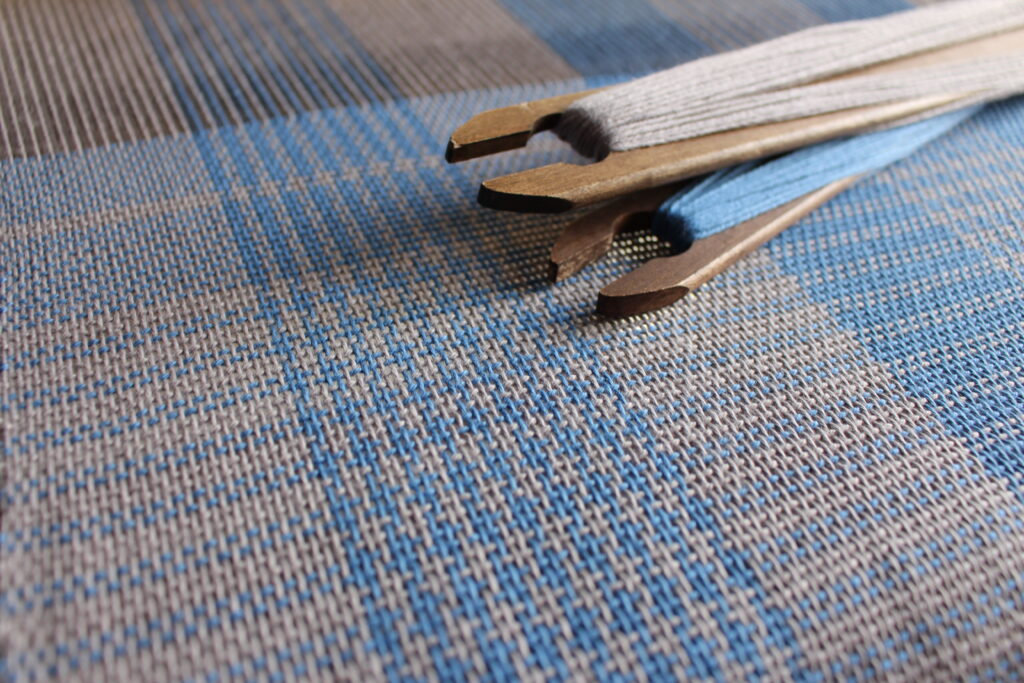
I’m happy to share with you the video about the weaving of those Houndstooth dishtowels with 8/4 cotton on my rigid heddle loom. It’s very detailed and this page aims to fill some gaps that there might be in some of my explanation during the video.
For disclaimer, links included on this page might be affiliate links. This means that if you purchase a product or service with the links that I provide, I may receive a small commission. Please note that there is no additional charge to you. This is just a way for me to keep making this content. Thank you for your support!
The Warping
I have already made a whole video about the warping for this project. Here’s where you can watch it.
I have also wrote a page about it, in which I give all the details about the warp pattern. Here’s where you can view it.
The Yarn
Here’s more details about the yarn I used in this project. I chose to weave the towels Hobbii’s cones of 8/4 cotton. For the colors, I have decided to go with a light gray, which name is “Ash” (07) and a light blue which name is “Cornflower” (17). The cones are pretty massive and each of them contains around 1700m (1856yds) of yarn. I should be able to make a few projects out of them!
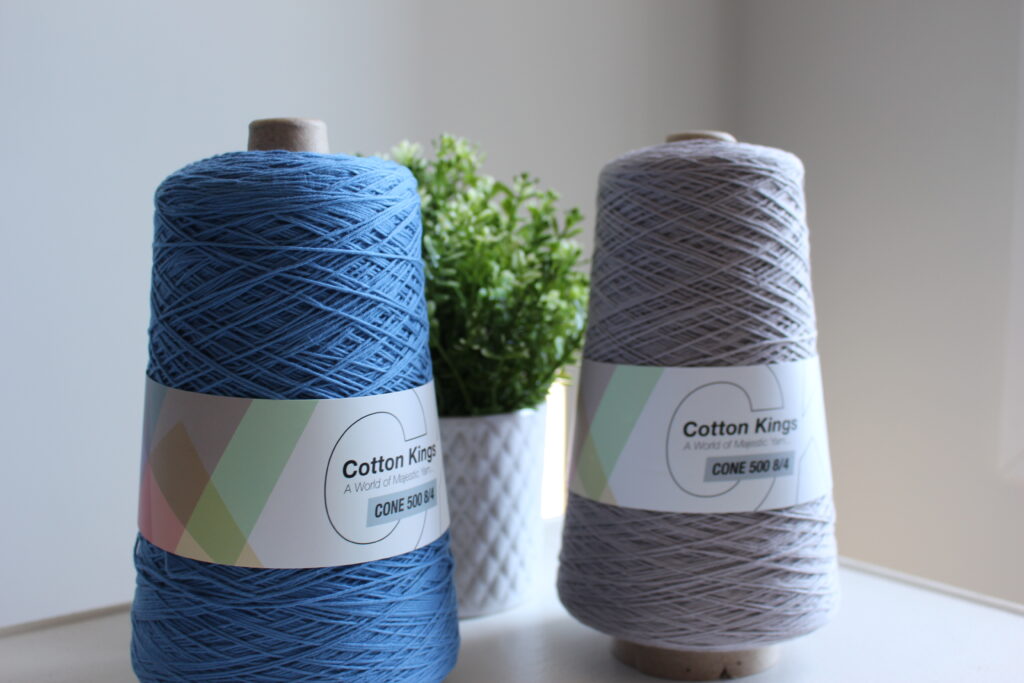
Here’s a link to Hobbii’s website, where you can get the same yarn:
The Specifics
For this project, I used my 12.5 DPI heddle and I singled my threads in each dent. I have warped a width of 23.5” (58cm) and the project has 294 ends.
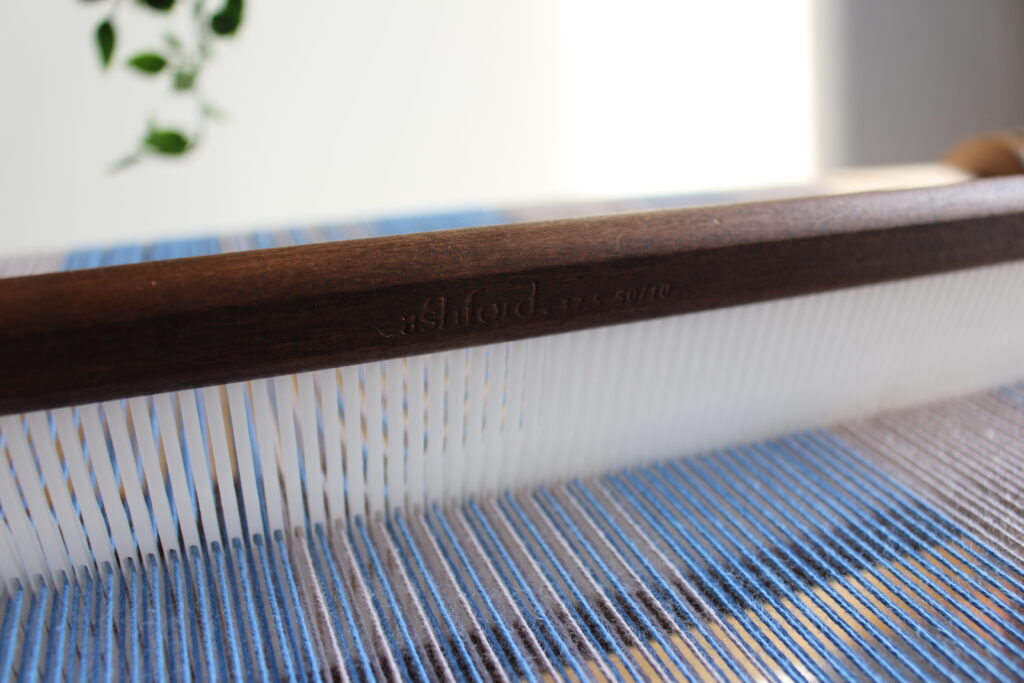
I warped a length of about 100” (2.5m). I believed that this should be enough to weave 2 dishtowels of about 40” (1m) long each and allow for about 22” (50cm) of waste yarn. Still, I ended up having a little less scrap yarn than that, which allowed me to leave about 4” of fringes in between my woven towels. If I were to redo this project, I would probably warp for about 4” (10cm) longer just to have a bit more wiggle room and have both towels the same size.
The First Towel
For this first towel, I wanted to replicate the design that I have in the warp into the weft. In the warp, I have two blocks of color: a gray block and a blue block. The blue block is found once, in the middle of the warp. The gray block is found twice in the warp: once on left and once on the right. Both blocks are basically the same, it’s simply that the colors are reversed.

The Gray Block of Color
I decided to start with the gray block of color, since that’s the first block that we see when looking at the pattern from left to right (or right to left in this case since that my pattern is symmetrical).
At first, I wove for about 2,5” (6.4cm) with gray. This makes a squarish rectangle. I know that after the towel is off the loom, off the tension and weft finished, it should shrink into a more square looking section.
Then, I wove the houndstooth pattern. For houndstooth, I need to weave 2 picks of each color and alternate them. My goal was to weave houndstooth until a reach something close to 3” (7.5cm) long. For me, this meant 7 pairs of blue picks and 6 pairs of gray picks. I recommend watching the video above for more information about how to weave houndstooth.
Then, I moved back to weaving about 2.5” of gray. And just like that, my first gray block of color was done.
The Blue Block of Color
Then, I moved on to weaving the blue block of color which is the same as the gray, but in reverse! In a nutshell, I wove for about 2.5” of blue. Then I wove the houndstooth pattern in which I made 7 pairs of gray picks and 6 pairs of blue picks. After that, I wove for another 2.5” of blue.
The Whole Towel
I alternated in between those two blocks of colors all the way through the towel. At the end, I had woven 3 blocks of gray and 2 blocks of blue. If my calculation were right, I should have finished with a length of exactly 40”. However, I ended up with 44”. The reason for this is that my measurement throughout the towel were approximative. For some gray and blue sections, I wove for a bit more than 2.5”. I got in the rhythm of weaving and I wove a few extra picks! Who can blame me? I didn’t want to unweave so I left it there. All of those extra picks ended up being a bit much at the end! Next time, I will be more careful.

Once I realised that my towel would be longer then expected, I had two options. The first one was to stop weaving after the second block of blue. At this point, I had a bit more than 35” woven. Or I could keep weaving one extra block of gray, knowing that this towel will be longer than 40”. This also meant that the second towel will have to be shorter than the first one. I decided on the second option, because I wanted to finish the towel with the same block of color as the first in order to have a symmetrical looking towel. As those towels are for my own personal use, I don’t mind having them not the same size.
The Houndstooth Pattern
I love houndstooth! This is such an easy, yet beautiful pattern to achieve on rigid heddle looms. I find it also really accessible to newer weavers because of its simplicity. However, there is one part that can become tricky and it’s at the selvedges. I recommend watching the video above for detailed explanation on how to weave this pattern and achieve neat selvedges at the same time.
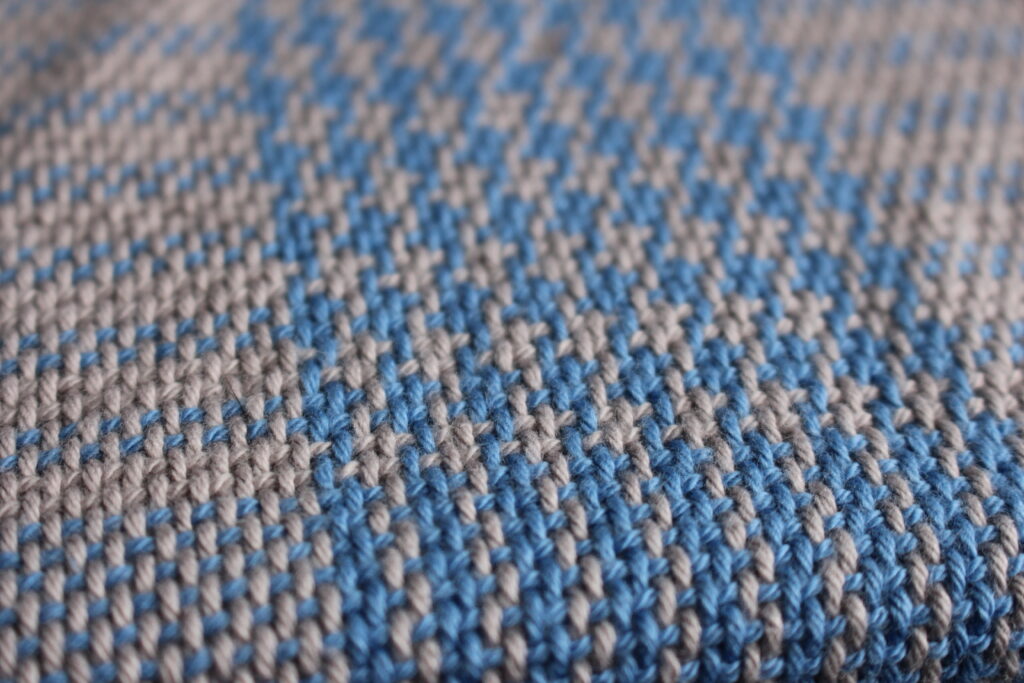
Also, I feel the need to mention two things about the houndstooth on this project. First of all, as I was weaving it, the houndstooth pattern was not obvious. It really came to life after the weft finishing process. At this point, that the yarn bloomed and filled up the gaps in between the picks, making the pattern pop more.
Also, the colors I chose are pastel and they are not really contrasting. This means that my houndstooth pattern is not really loud and out there. This is the effect I was going for: subtle hints of houndstooth. However, if you wanted yours to pop more, I would recommend choosing more contrasting colors.
The Second Towel
For this second towel, I wanted to really go outside of my comfort zone! I wanted to go with the flow, and at the same time experience different pattern options. Still, I wanted to keep a lot houndstooth inside of the towel.
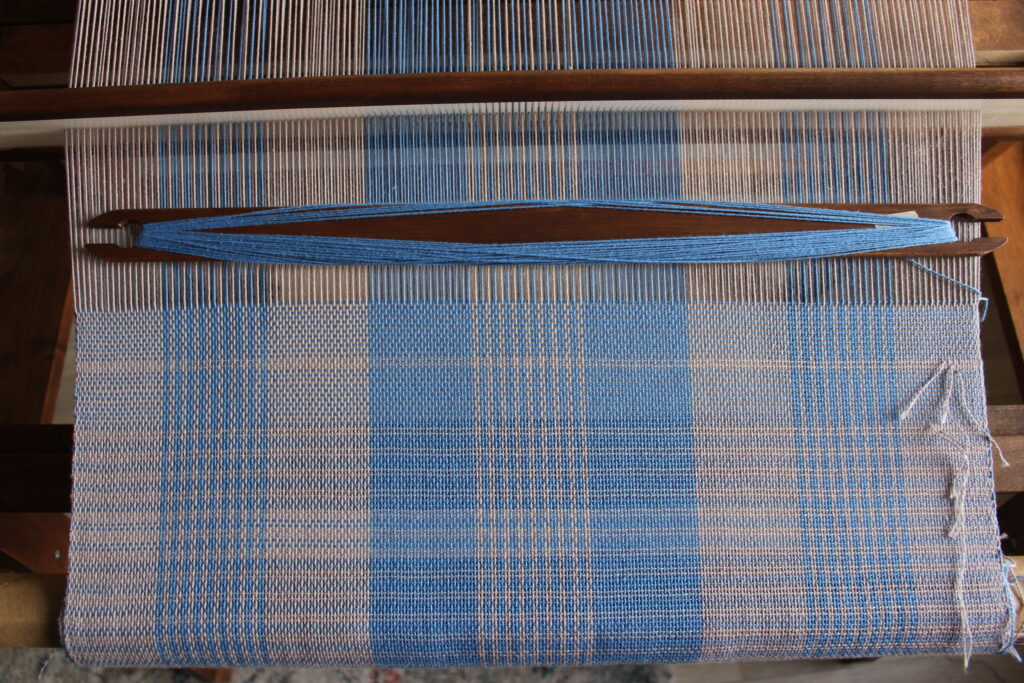
I started off by weaving a lot of gray and some stripes of houndstooth. Then, I wove a big length of only houndstooth. After that, I wove a sequence with a lot of blue and one stripe of houndstooth in between every few inches of the fabric. Finally, I wove a gray section again with only a few stripes of houndstooth. I made sure to start and finish with gray in order to have my hemstitches made with the same color at both extremities. I wove the towel for about 36”.
Thoughts on the Second Towel
I’m glad I did this exercise because it gave me a lot of inspiration for future projects. It might also give other weavers some inspiration to weave their own funky second towel! I really love the part where I wove the blue section with only a stripe of gray here and there. I believe that if I had woven the whole towel this way, it would have turned out beautifully. Also, I like the part where I continuously wove houndstooth. I felt like this could also make a wonderful towel.
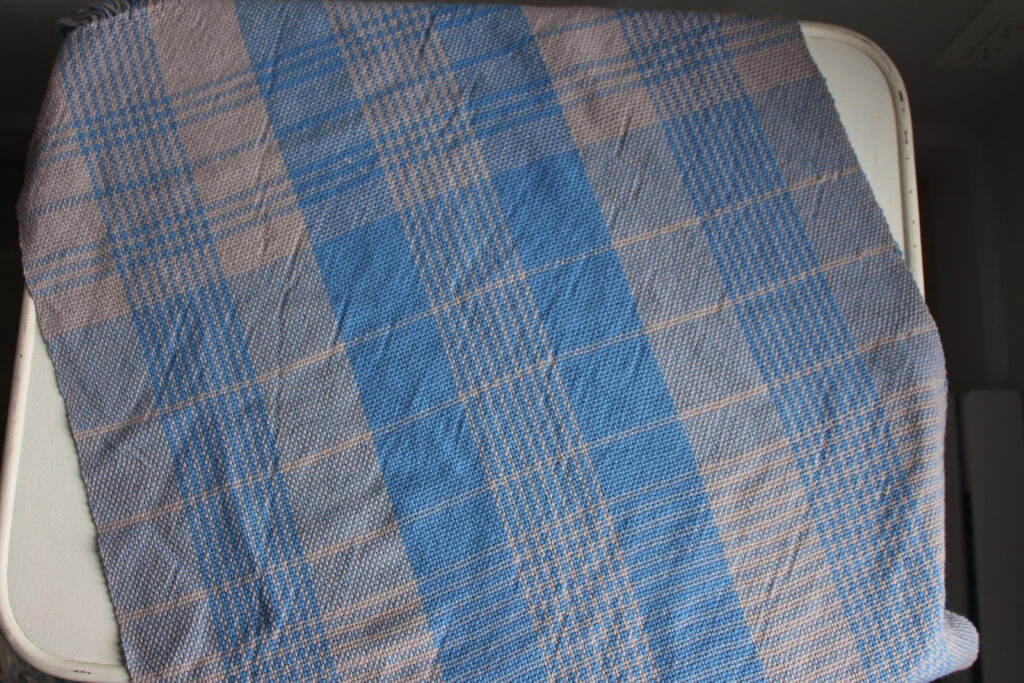
On top of that, I like all of those patterns living together on the same towel! This gives me tons of ideas to exploit while using all the yardage left on my cones.
Hemstitching and Finishing Touches
I decided to hemstitch both my towels. The reason for this is that I didn’t want to hem those towels! Since that they are woven with 8/4 cotton, they are by definition thicker than my 8/2 cotton towels. I thought that it would them make thick sewn hems and I thought that a hemstitch might actually give a finer finished. This implied that I would leave some fringes on and I actually liked the though of it.
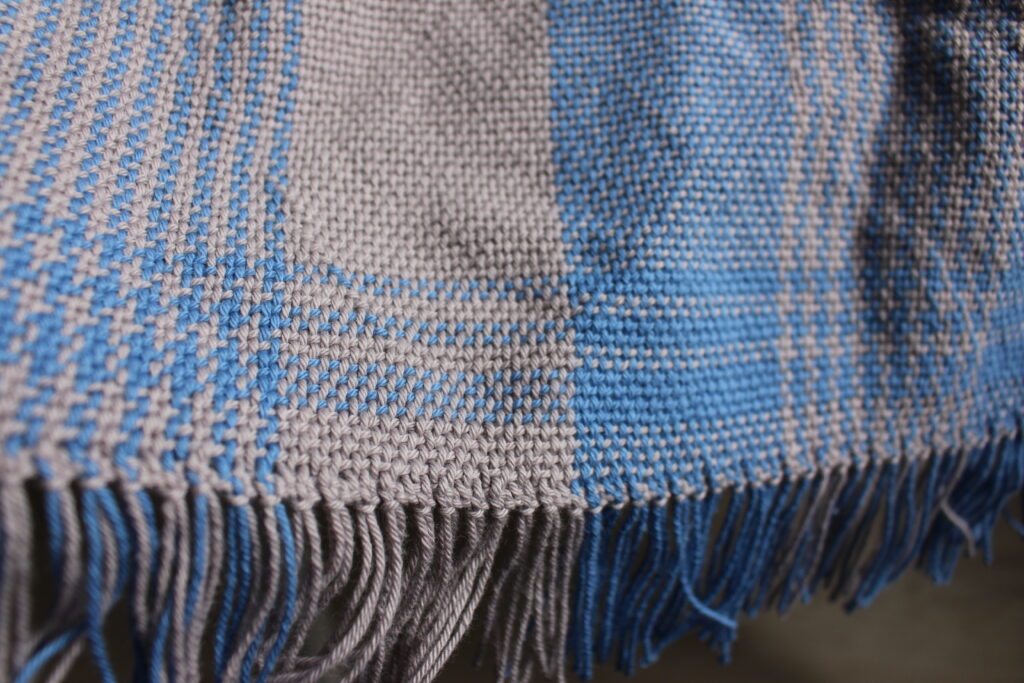
For my hemstitch, I made bundles of 2 weft threads and 3 warp threads. I left fringes of about 1.5” (4cm) on each end of both towels.
Dimensions of the Finished Towels
After wet finishing, the towels shrank quite a lot. The first towel now measures 37” without fringes. The second towel now measures 31”. I estimate a shrinkage of about 15%.
Conclusion
Compared to my towels woven with 8/2 cotton, those towels sure feel and look thicker. But this doesn’t mean that I don’t like them! I actually enjoy this thicker feel. Most importantly, I loved the process of weaving of those Houndstooth dishtowels with 8/4 cotton.
Another question remains: will those towels be as absorbent as the towels I wove with Maurice Brassard yarn? Well for this, only time will tell!